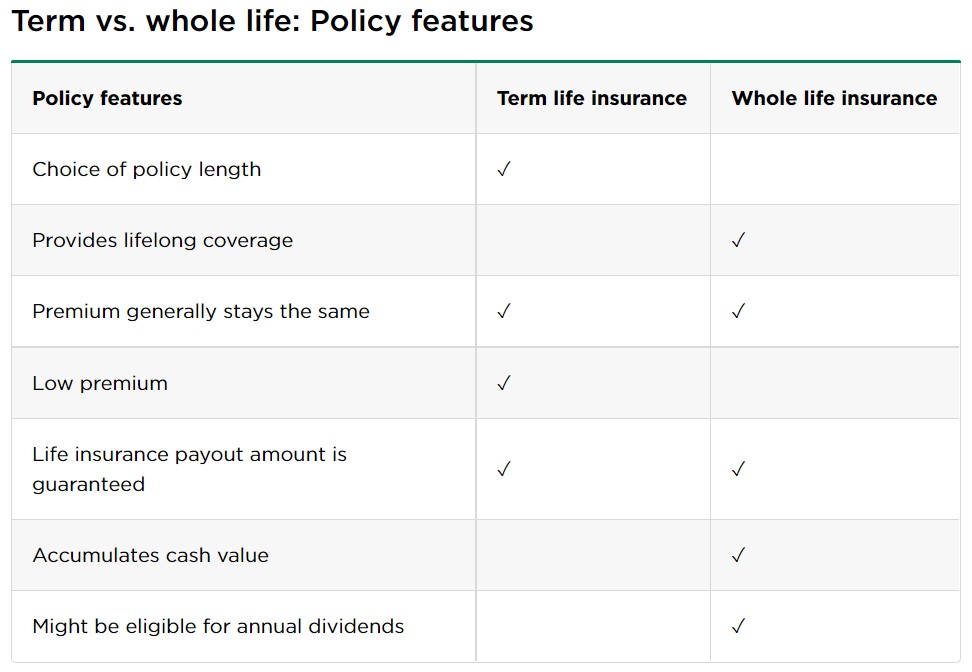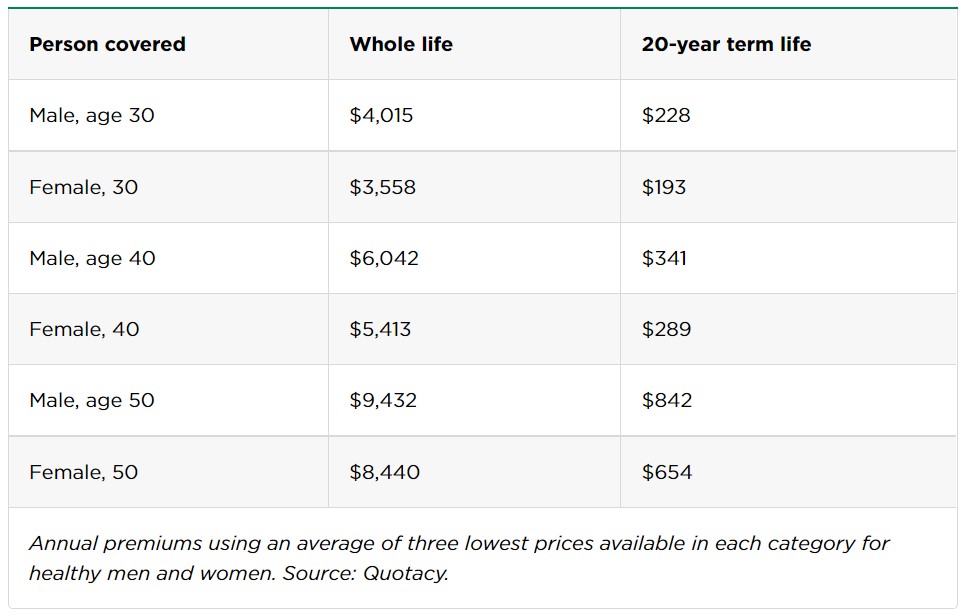Whole life insurance can give you lifelong coverage and provide extra support during retirement. Term life insurance covers you for a shorter period, but it’s cheaper and simpler. After you’re gone, your family can use the proceeds from either type of policy to cover funeral costs, mortgage payments, college tuition and other expenses.
While the death benefits of whole and term life can be similar, there are key differences between these two popular types of life insurance.
What is the difference between term and whole life insurance?
Term life insurance is the easiest to understand and has the lowest prices. It covers you for a fixed period of time, like 10, 20 or 30 years. If you don’t die during the term, your coverage ends and no one receives any money.
Whole life insurance is more complex and tends to cost more than term, but it offers additional benefits. Whole life is the most well known and simplest form of permanent life insurance, which covers you until you die. It also provides a cash-value account that you can tap for funds later in life.
Want to know more? Here’s a closer look at whole life and term life insurance.
What is term life insurance?
Term life insurance provides coverage for a certain time period. It’s often called “pure life insurance” because it’s designed only to protect your dependents in case you die prematurely. If you have a term policy and die within the term, your beneficiaries receive the payout. The policy has no other value
You choose the term when you buy the policy. Common terms are 10, 20 and 30 years. With most policies, the payout — called the death benefit — and the cost, or premium, stay the same throughout the term.
When you shop for term life:
- Choose a term that covers the years you’ll be paying the bills and want life insurance in case you die.
- Buy an amount your family would need if you were no longer there to provide for them. The payout could replace your income and help your family pay for services you perform now, such as child care.
Ideally, your need for life insurance will end around the time the term life policy expires: Your kids will be on their own, you’ll have paid off your house and you’ll have plenty of money in savings to serve as a financial safety net.
All of the best life insurance companies sell term life, so it’s easy to find rates. You can get life insurance quotes online.
What is whole life insurance?
Whole life insurance provides lifelong coverage and includes an investment component known as the policy’s cash value. The cash value grows slowly in a tax-deferred account, meaning you won’t pay taxes on its gains while they’re accumulating
You can borrow money against the account or surrender the policy for cash. But if you don’t repay policy loans with interest, you’ll reduce your death benefit, and if you surrender the policy, you’ll no longer have coverage.
Although it’s more complicated than term life insurance, whole life is the most straightforward form of permanent life insurance. Here’s why:
- The premium remains the same for as long as you live.
- The death benefit is guaranteed.
- The cash value account grows at a guaranteed rate.
Some whole life policies can also earn annual dividends, which pay you back with a bit of the insurer’s profit. You can take the dividends in cash, leave them in your account to earn interest or use them to decrease your premium payments, repay policy loans or buy additional coverage. Dividends aren’t guaranteed.

Term vs. whole life: Cost comparison
Term life insurance is cheap because it’s temporary and has no cash value; in most cases, your family won’t receive a payout because you’ll live to the end of the term. Whole life insurance premiums are much higher because the coverage lasts for a lifetime, and the policy has cash value, with a guaranteed rate of investment return on a portion of the money that you pay.
Below are annual price comparisons between term life and whole life insurance for a $500,000 policy. We used the most common term length, 20 years, because no apples-to-apples comparison is possible for the length of term life to whole life.

Term vs. whole life: Which to choose
Term life is sufficient for most families, but whole life and other forms of permanent coverage can be useful in certain situations.
Choose term life if you:
- Only need life insurance to replace your income over a certain period, such as the years you’re raising children or paying off your mortgage.
- Want the most affordable coverage.
- Think you might want permanent life insurance but can’t afford it. Most term life policies are convertible to permanent coverage. The deadline for conversion varies by policy.
- Think you can invest your money better. Buying a cheaper term life policy lets you invest what you would have paid for a whole life policy.
Choose whole life if you:
- Want to provide money for your heirs to pay inheritance or estate taxes. In 2021, estates worth more than $11.7 million per individual or $23.4 million per couple are subject to federal estate taxes. State inheritance and estate taxes vary.
- Have a lifelong dependent, such as a child with disabilities. Life insurance can fund a trust to provide care for your child after you’re gone. Consult with an attorney and financial advisor to set up a trust.
- Want to spend retirement savings and still leave an inheritance or money for final expenses, such as funeral costs.
- Want to equalize inheritances. If you plan to leave a business or property to one child, whole life insurance could compensate other children.
Other life insurance options
If you need lifelong coverage but want more investing options in your life insurance than whole life provides, consider other types of permanent life insurance.
- Universal life insurance pays interest based on current market rates (like those that determine mortgage interest rates).
- Variable life insurance or variable universal life insurance both give you access to direct investment in the stock market.
- Indexed universal life insurance pays interest based on the movement of stock indexes.
In addition to the investments they offer, all of these options can also be cheaper than whole life — if the market cooperates. While whole life and term policies have costs set from the beginning, these other options will have varying costs depending on the performance of your cash account and the policy choices you make. That can lead to great savings or to unexpected expenses.





